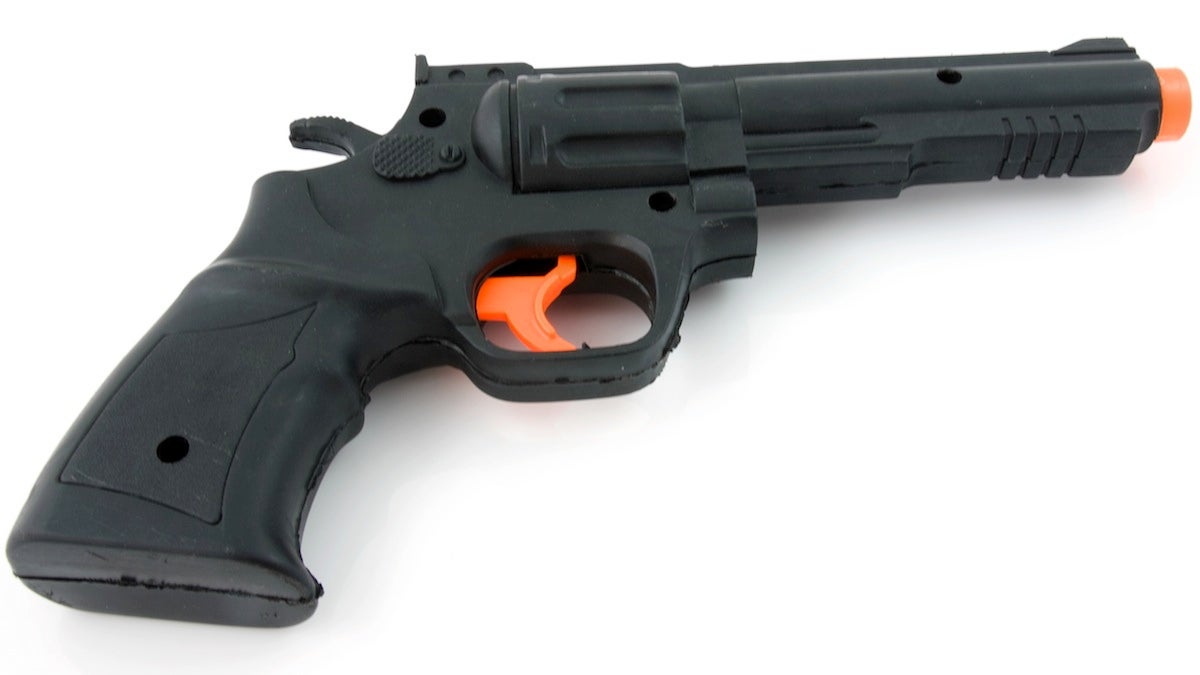The real danger of toy guns
Listen Shutterstock ) " title="shutterstock_gun" width="1" height="1"/>
Shutterstock ) " title="shutterstock_gun" width="1" height="1"/>
Toy gun (Courtesy of Shutterstock )
A few years ago Walmart stopped selling candy cigarettes, which had led generations of American youngsters into a very bad habit.
There’s strong evidence that children who use candy imitations become heavier cigarette smokers later in life.
But Walmart still carries imitation guns, which can also put kids–and many others–in mortal danger. It’s time to ask every merchant of fake weapons to cease and desist. And if they don’t, we should hit them with our own best weapon: a consumer boycott.
Last summer, a 22-year-old man picked a BB gun off the shelves at a Walmart in suburban Dayton, Ohio. A few moments later he was shot dead by police, who mistook it for an actual rifle. And last month, on the other side of the state, a 12-year-old Cleveland boy was killed by a policeman who thought that the boy’s toy gun was real.
Both victims were African-American, so these episodes have already been folded into the same racial narrative as the Ferguson shooting and the choking death of Eric Garner. But both of the Ohio young men would be alive if not for fake guns, which have proliferated in America since the 1950s.
That’s when television brought Roy Rogers, Wyatt Earp, and other cowboy heroes into our living rooms. Millions of boys donned toy holsters and pistols, modeled upon—and advertised by—TV characters. By 1958, 20 million toy guns were sold each year.
The guns would prevent boys from becoming “sissies,” advocates said, amid worries that postwar suburban affluence—and overprotective mothers—had eroded American masculinity. “It is perfectly natural for young boys to be fascinated by guns,” wrote one approving physician. “They represent an extension of power and strength.”
The fake guns would also steel American youth for the all-too-real struggle against Soviet Russia. “Peace depends on all of us being rugged and ready,” declared the caption of a Saturday Evening Post cover, which showed young American boys dressed as pistol-toting cowboys. If the magazine made it past Russian censors, it added, “comrades may be slightly startled by this portrayal of little capitalists frolicking amiably with one another.”
After the 1963 assassination of John F. Kennedy, some Americans started to question toy guns. In 1968, popular child-rearing expert Benjamin Spock advised parents against buying them; and later that year, in the wake of the murders of Martin Luther King, Jr. and Robert F. Kennedy, Sears and Bloomingdale’s suspended toy gun sales during the Christmas season.
But sales picked up again in the 1970s, spurred by tie-ins to the blockbuster Star Wars movies. They continued to soar until 1987, when a mentally disturbed man burst onto the set of a live Los Angeles television news broadcast, held a pellet gun to a reporter’s head, and forced him to read a statement warning about “space creatures” and the Central Intelligence Agency.
The following year brought the first federal toy gun law, which required a blaze-orange plug to be inserted into the visible end of every imitation firearm. Shortly after that, the government ruled that toy guns needed either the orange plug, a blaze-orange stripe around the barrel, or a translucent, brightly colored, or white exterior.
But BB and pellet guns were exempted from the legislation, while toy-gun owners often removed the orange plug or painted the guns to appear more real. And even when the fake guns retained their supposedly distinctive features, policemen couldn’t tell the difference. In a 1989 experiment organized by the National Institute of Justice, 96 percent of officers fired at actors carrying a toy gun with an orange plug and 77 percent fired at those armed with a gun that had an orange stripe around the barrel.
So we shouldn’t be surprised, really, when people wielding fake guns are gunned down. In 2012, police in Texas shot a 15-year-old eighth-grader to death when he refused to drop a BB gun he had brought to his middle school. Last year California police killed a 13-year-old boy carrying a replica rifle, leading the state legislature to pass a law requiring all such guns to be brightly colored.
And now, in the aftermath of the Ohio shootings, some critics are calling for outright bans on imitation guns. But it’s hard to see how such measures could be reasonably enforced, given the ubiquity of fake firearms in American society.
Instead, we need targeted voluntary efforts against them. A good start is the toy gun buyback proposed by community activists in Cleveland, who hope to offer books, other toys, or concert tickets in exchange for the guns. And following Dr. Spock, parents shouldn’t give their kids guns as presents.
But we should also urge merchants not to sell them. And the best way to do that is to stop patronizing the places that do. This holiday season, if you find yourself in a store that peddles weapons as playthings, take your business elsewhere. That’s the only sure-fire way that we will ever stop the scourge of fake guns.
WHYY is your source for fact-based, in-depth journalism and information. As a nonprofit organization, we rely on financial support from readers like you. Please give today.

